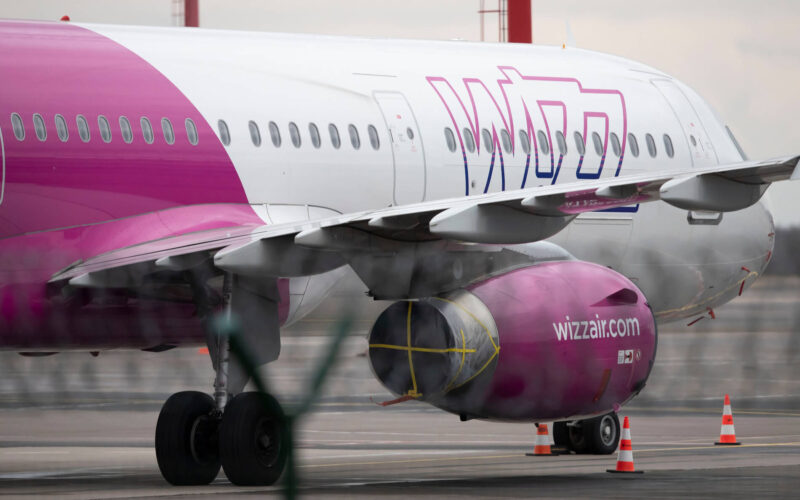On June 16, 2020, a Wizz Air Airbus A321 (registered as G-WUKJ) was forced to reject two take-offs in one day. Prior to the unsuccessful attempt to leave Doncaster Sheffield Airport (DSA), the aircraft was parked in long-term storage for nearly 12 weeks.
The A321 was due to make a ferry flight to London Stansted Airport (STN) to re-enter service following almost 12 weeks of storage, according to an incident report by the United Kingdom Civil Aviation Authority (CAA), released on November 11, 2020. The low-cost carrier sent the aircraft to be parked at the airport on March 25, 2020, just as borders across Europe were being closed down. The Airbus A321 was prepared for long-term storage in a “flight-ready” condition, noted the report. Maintenance to keep it in that condition was carried out according to the Aircraft Maintenance Manual (AMM) by a DSA-based Part 145 Aircraft Maintenance Organization (AMO).
Shortly before the aircraft was set to return to service, maintenance personnel from the AMO flushed the Air Data System on June 9, 2020. Six days later, engineers on the ground performed work on the narrow-body in order to prepare it to return to service the following day.
Air Data Reference faults
On June 16, 2020, the A321 was given the all-clear to return to service and was subsequently scheduled to fly to Stansted to return to commercial service. On the day of the ferry flight, which included only the pilots onboard, the two flight crew members conducted their own walkarounds in order to make sure nothing went wrong during the storage period.
“They found no faults,” concluded the CAA’s report.
Around 10:30 AM local time (UTC +1) the pilots prepared to leave Doncaster. The Wizz Air aircraft taxied to a designated holding point and Air Traffic Control (ATC) cleared the aircraft to take-off from Runway 20. Already during the initial acceleration, the captain noticed that his Primary Flight Display (PFD) showcased increased airspeed, despite the aircraft still being on the ground. When the Airbus A321 continued to accelerate down Runway 20, the captain also noticed a flock of birds in the take-off path.
However, as he returned to scan his instruments on the right-hand side display, his speed indication showcased zero. Following a cross-check with the first officer’s PFD, the captain called to reject the take-off and applied maximum reverse thrust and automatic brakes, successfully stopping on the runway.
The decision to abandon the take-off was taken at 120 kt, which also was the latest speed at which the crew can stop the departure and still stop on the runway (V1). A post-flight inspection showcased that the flight Electronic Centralized Aircraft Monitor (ECAM) indicated a failure message that was related to the number 1 Air Data Reference (ADR1).
The AMO performed troubleshooting on the aircraft, switching up the number 1 and 3 Air Data Inertial Reference Units (ADIRU). Following a successful ground test, the maintenance personnel once again permitted the Wizz Air aircraft to leave the South Yorkshire airport.
Sneaky larvae
However, the maintenance was to no avail – the flight crew, five hours after the initial attempt to depart from Doncaster, had to reject the take-off once again as the PFD was still not registering airspeed.
For the next two days, the Airbus A321 stayed at the airport in order to fix the bug that has affected the aircraft. Following a pitot probe flush, three small insect larvae were freed from the number 1 pitot probe after they were found inside the probe.
“The larvae were not retained to enable further identification of the insect species,” read the incident report.
According to the CAA, the airline concluded that the larvae “may have been deposited in the pitot probe whilst it was parked with the pitot probe covers fitted.” The pitot probe covers, used to preserve them during storage, do not fully seal to avoid “differential pressure measurement issues in the air data system,” noted the authority.
“It is, therefore, possible that an insect could enter the air data system during prolonged parking,” concluded the CAA. However, the investigators also did not rule out the fact that the larvae could have snuck into the pitot probe once preparation work to return the aircraft to service began or that they were already inside the covers prior to their installation.
As a result of the incident, Wizz Air introduced a requirement that all aircraft that were stored for a longer period than three days now had to undergo a procedure whereupon all total and static pressure lines would be flushed. In addition, Airbus is looking to update the maintenance manual of the A320 family to include an air data system flushing procedure following a prolonged period of storage, stated the CAA.
Storage a cause for concern?
Could storage provide an extra layer of migraine for airlines during the current crisis?
For example, in July 2020, the Federal Aviation Administration (FAA) issued an Airworthiness Directive (AD) for all stored Boeing 737 Classic and 737 NextGeneration (NG) aircraft. The AD warned operators that potential corrosion on the engine’s bleed air fifth stage check valve CFM56 engine family that power both the Classic (CFM56-3) and the NG (CFM56-7B) could lead to double-engine shutdown without a way to restart the power plants.
The administration issued the directive following four separate events of an engine shutting down mid-flight following a longer period of storage.

